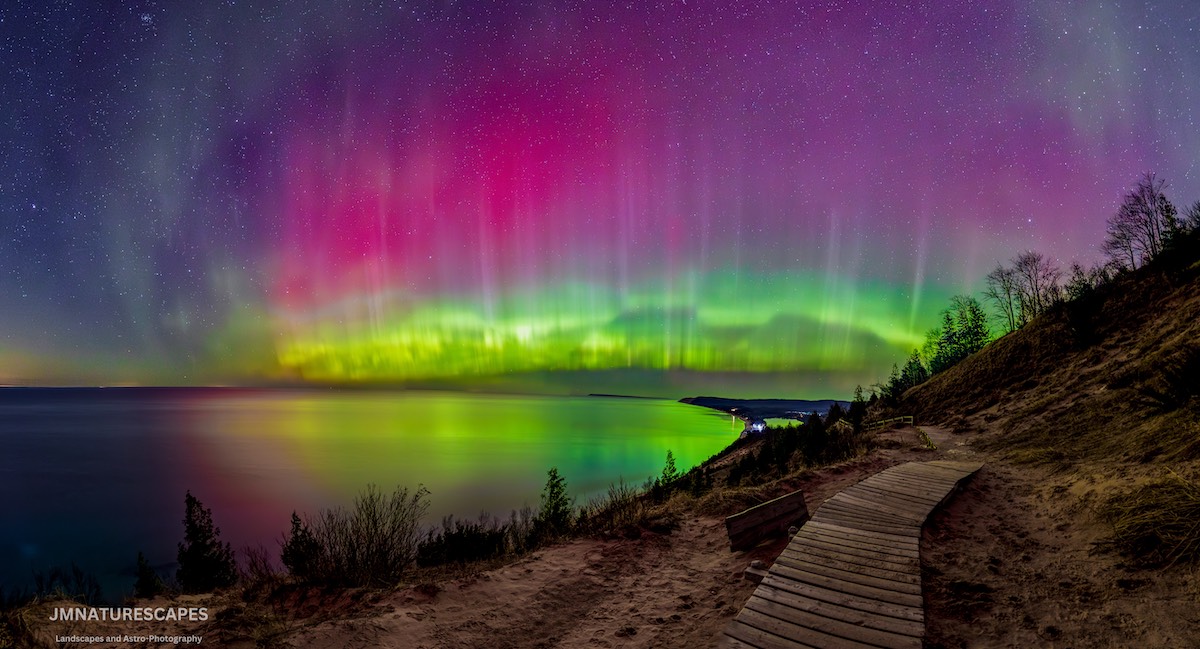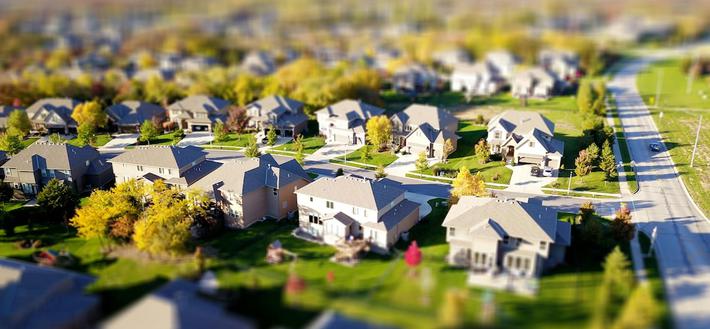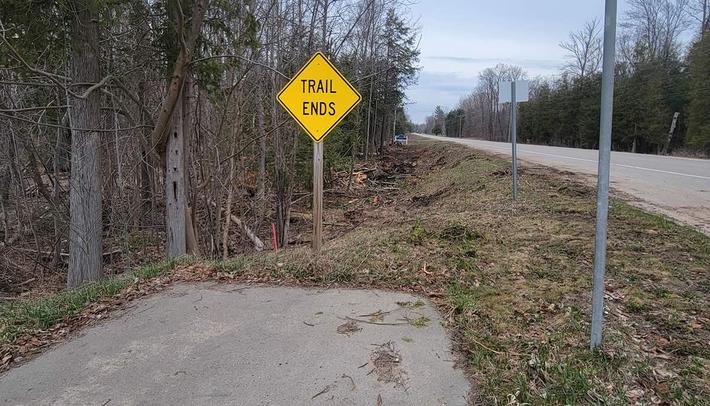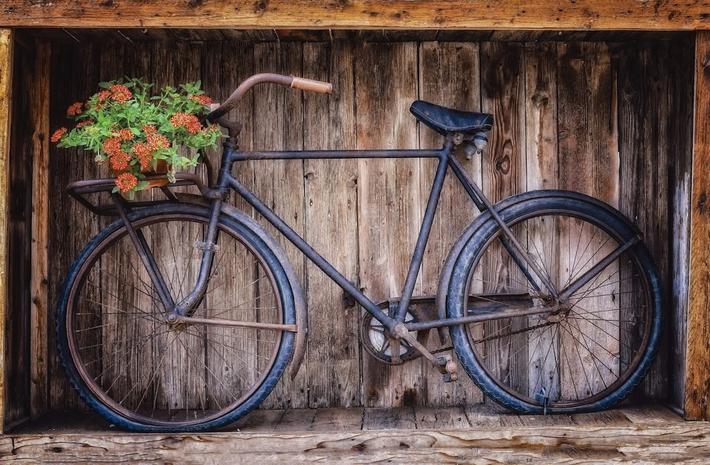
Aurora Chasers Teach Us How to Watch the Sky
Michigan’s experts share favorite spots and best tips for catching the northern lights
By Craig Manning | Nov. 11, 2023
Meet the Michigan Aurora Chasers, a massive—and growing—Facebook community of northern lights enthusiasts who use every tool at their disposal to track down, witness, and photograph the vibrant colors of the aurora as often as possible.
Established in January 2021 by Melissa Kaelin, an Ann Arbor-based aurora expert, the Aurora Chasers group has a stated goal of helping “people in Michigan and surrounding areas find and photograph the northern lights.” In less than three years, it’s grown into a massive community spanning 93,500 people; Kaelin expects it will pass the 100,000 mark by the end of the year.
That’s not an insignificant achievement, but perhaps it also isn’t a surprising one. Michigan, thanks to its expansive Great Lakes shoreline, geographical positioning on the 45th parallel, and relative lack of light pollution, is one of the best places in the entire country to see the aurora. And since there are few spots in the state that exhibit those three attributes better than in northern Michigan, it stands to reason that spots like Leelanau County are becoming increasingly popular destinations for aurora chasers from far and wide.
Northern Michigan: An Aurora Chaser’s Mecca?
Just ask Kaelin, who started chasing the aurora over a decade ago when she lived in Minnesota. When Kaelin relocated to the Mitten, she wanted to find a few things—namely, a like-minded group of individuals who loved aurora chasing as much as she did and great places to see the northern lights. The former desire led Kaelin to start the Michigan Aurora Chasers group. The latter led her north.
“I love northern Michigan, and I go north as much as I can,” Kaelin tells Northern Express, specifying areas like Leelanau County’s Glen Haven Beach and the Archangel Gabriel Orthodox Church in Williamsburg as spots that are particularly terrific for seeing the northern lights.
As Kaelin explains it, there are scientific reasons for why northern Michigan is such a good place to behold the aurora.
One of the common ways to measure the aurora, she says, is with the planetary K-index. The K-index measures geomagnetic activity, or disturbances to the Earth’s magnetic field. Those disturbances occur due to solar winds or other flare-ups of solar weather, all of which originate from things happening on the surface of the sun, like coronal holes or solar flares. Solar activity flings electrons toward the Earth, and when those particles interact with the planet’s magnetic field, the aurora is the visible result.
Most of the time, those interactions are visible only from the Earth’s magnetic poles, which is why the northern lights are a regular sight from the Arctic and Antarctic circles and a special occurrence everywhere else. Sometimes, though, especially powerful solar eruptions cause more extreme geomagnetic disturbances, which can in turn make the aurora visible farther from the poles.
Of course, predicting weather in space is even more difficult than predicting weather here on Earth, which is why guessing where and when the aurora will be visible is difficult—especially for beginners. But Kaelin says that keeping an eye on the K-index is usually the best way to know if/when the northern lights will be showing up in the sky.
The scale ranges from 0 to 9, with higher numbers indicating higher levels of geomagnetic activity. If the K-index reading is closer to a 9, the aurora will be brighter in the sky and visible farther from the poles.
“A lot of people don’t realize that even though we need strong activity in Michigan to see the aurora, we only need about a K-6 to see it across the entire state, and only a K-5 in Traverse City or anywhere along the 45th parallel,” Kaelin explains. “A K-5 is something that happens quite often, so if you’re in northern Michigan, you’re going to be able to see the aurora pretty frequently.”
Meet the Chasers
Ethan Hohnke knows he’s lucky to live in northern Michigan. A member of Kaelin’s Michigan Aurora Chasers group—she calls him one of the leading aurora photographers in the state—Hohnke happens to call Leelanau County home.
Between April 2022 and September 2023, he strung together an 18-month streak where he saw and photographed the northern lights at least once per month. The vast majority of those sightings happened close to home. (October 2023, with its ample rainfall and endless cloud cover, broke Hohnke’s streak.)
For Hohnke, the convenience of catching the aurora near where he lives has been a blessing for multiple reasons. In the depths of the pandemic, Hohnke says he was “in a darker place.” His pre-pandemic dream of opening a hard cider company had ground to a halt when the world shut down, and he found himself feeling aimless and sad.
“I caught my first aurora in March of 2021, and it kind of gave me this refound purpose in life,” Hohnke tells Northern Express. “Prior to that, I hadn’t even had a camera. I just would occasionally capture things on my cell phone.”
Within a month, Hohnke was “hooked.” He bought his first camera, downloaded apps for tracking the aurora, and set to work learning the ropes of how to take photos that did justice to the beauty of the northern lights. Now, he’s a photographer by trade, working at Vada Color—a fine art printing business in Traverse City—and using Etsy to sell prints, calendars, and canvas wraps under the business name Captures By Ethan.
Looking back, Hohnke sees his March 2021 aurora introduction as the “ultimate segue” into a new career and a new life chapter. He’s grateful he lives in a place where that kind of epiphany could happen almost by chance.
For some Michigan Aurora Chasers, getting to northern Michigan to catch an aurora is more of a commitment, but still a worthwhile one. Just ask Justin Miller, a Grand Rapids-based photographer who moved to Michigan in late 2021. A transplant from Texas, Miller had never seen the northern lights before, let alone photographed them.
“I’ve always had a massive soft spot in my heart for astronomy, and I’ve always loved what’s called ‘landscape astrophotography,’ which is shots of beautiful landscapes under the night sky,” Miller says. When he moved to Michigan, Miller “immediately scoped out” spots for nighttime photography in the state. That search led him to areas like the Sleeping Bear Dunes National Lakeshore.
One night, in the midst of a nighttime shoot over Silver Lake, Miller found himself photographing the northern lights for the first time. Unlike most of the people in the Michigan Aurora Chasers group he’d recently joined, Miller hadn’t planned on shooting or even seeing the lights. Instead, he simply caught a lucky break on a lucky night.
“My mind was just blown,” Miller recalls. “I didn't even know, moving to Michigan, that it was possible to photograph or even see [the northern lights] here.” Since then, Miller estimates he’s photographed the aurora over 20 times in the span of about 16 months.
Tips from the Experts
So, what do you need if you want to take up the mantle of aurora chaser?
The good news is that you already have at least one big thing going for you: You’re in northern Michigan! Per Kaelin, it’s also just about the perfect time of year to start aurora chasing, given that the peak season for catching the northern lights in Michigan tends to fall between September and April. Crisp, cold, dark, and clear winter nights, she says, often yield some of the most fruitful aurora chases of the year.
Some of the best practices to aurora chasing are self-explanatory: Wait for a cloudless night, find a dark area with a good northerly view, and get used to tracking the K-index. Joining the Michigan Aurora Chasers group is one way to get dialed in on the aurora-watching conditions. Another is to use mobile apps like My Aurora Forecast to monitor geomagnetic activity. Kaelin also recommends using light pollution maps to find areas near you that offer the darkest skies possible.
Michele Aucello, another northern Michigan-based aurora chaser, says the most important things—beyond favorable Earth and space weather conditions, of course—might be expectations and patience. While the northern lights can often be seen with the naked eye, a good camera can capture colors and dimensions of the aurora the eyes can’t. Accepting that fact, Aucello says, is a common frustration among first-time aurora viewers, as is realizing that an iPhone camera isn’t going to yield the same results as an expensive camera with the right lenses, tripods, and settings.
Hohnke echoes Aucello’s words, noting that it took him investing in a good camera—and figuring out how to shoot in “manual mode,” with full control over things like shutter speed and exposure—to see everything the northern lights had to offer.
For aurora chasers without all that shiny equipment, Aucello simply recommends taking your time to get your eyes adjusted to the dark. Many people, she says, have the tendency to take their blankets and chairs out to the beach, watch the sky for a few minutes, and then get impatient. Once the phone comes out, the process of getting the eyes used to the dark starts all over again.
“That’s probably the hardest part of aurora chasing, because it is really tempting to pull out your phone and say, ‘Hey, what else is going on? What are other people on the Aurora Chasers app saying?’” Aucello says. “But if you can go out with some friends and plan on just hunkering down, the more your eyes are accustomed to the dark and the more you're going to see. I’ve seen amazing pinks and greens with the naked eye, but I do notice that’s what I’ve been out for an hour or so.”
“I would recommend that people devote at least three hours to an aurora chase,” Kaelin concludes. “A lot of people go out there as soon as it gets dark, look at the sky for 15 minutes, see nothing, and then give up and go home. If that’s the way you’re chasing, you’re going to miss the northern lights every time.”
Photo by Justin Miller
Trending

Walking in an Artsy Wonderland
Michigan Legacy Art Park is hosting the “Raindrops” artwork created by Dewey Blocksma and Patricia Innis at th... Read More >>
Seven Takeaways from Local Real Estate Agents for the Spring/Summer Market
The last few years in local real estate have been akin to what one local agent described as the “wild west,” w... Read More >>
Blazing the Boyne City to Charlevoix Trail
We’re getting ever closer to an interconnected northern Michigan thanks to ongoing work on the Boyne City to Charlev... Read More >>


